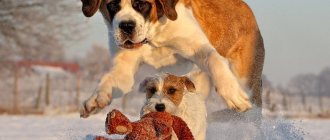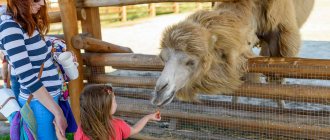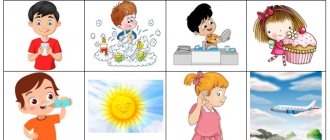LiveInternetLiveInternet
Quote from Tatyana57
Read in full In your quotation book or community!
SPEECH DEVELOPMENT. LEXICAL TOPIC “PETS AND THEIR CHILDREN”
CHILDREN SHOULD KNOW THE NOUNS: cat, cat, kitten, dog, dog, puppy, cow, bull, calf, horse, horse, foal, pig, hog, piglet, goat, goat, kid, sheep, ram, lamb, rabbit, rabbit , baby rabbit, herd, herd, pigsty, shepherd, milkmaid, pig farm, horns, hooves, tail, mane, fur - wool, stubble, bone, paws, farm, collective farm, udder, nostrils, stable, can, collective farmer (tsa), oats, swill, hay, muzzle, head, mouth, claws, hooves, ears, jaw, leather, saddle, bridle, whip, cart, kennel, pasture, rabbitry, groom, bangs, snout, nickel, animals ADJECTIVES: short, long , soft, fluffy, gray, red, smooth, shaggy, hard, thick, curly, domestic, smooth-haired, guard, sanitary, border, fire, circus, affectionate, kind, mustachioed, clumsy, strong, fast, weak, long-eared, faithful , funny, amusing, spotty. VERBS: meows, moos, barks, grunts, neighs, chews, bleats, gnaws, purrs, laps, grazes, eats, digs, harnesses, gnaws, kicks, runs, butts, feed, care for, jumps, carries, gives milk, catches , guards, guards, prances, jumps, licks, tugs, plays, makes friends. CHILDREN SHOULD BE ABLE TO FIND CHILDREN AND THEIR PARENTS AND VICE VICE: A cat has a kitten, a dog has a puppy, a goat has a kid...
SELECT SIGNS: Puppy - small, long-eared, funny, stupid, funny.. Calf - ..., Cat - ..., Rabbit - ... DESCRIBE ANIMALS ACCORDING TO PLAN: Name. Appearance. What does it eat? Where he lives. How he gives his voice. What benefits does it bring? Tell the children what benefits pets bring: - a dog and a dog guard the house; — a cat and a cat catch mice; - a cow gives milk and meat, but a bull only gives meat; - horse, horse, donkey, donkey, camel and she-camel, transport goods or people on horseback; - pig and boar provide meat and stubble; - sheep and ram - wool and meat; - a rabbit and a female rabbit give fur; - a goat gives wool, a goat gives wool and milk. Talk with the children about what they feed domestic animals, what kind of housing they live in, who the groom, pig farmer, milkmaid, and cattleman take care of. COMPARE TWO ANIMALS ACCORDING TO PLAN: What body? What is it covered with? What ears, nose, eyes, tail, muzzle...? What do they eat? Where live?Game: “Tell me which one?” (Adjectives describing appearance). Big, small, fluffy, spotted, purebred, large, Game: “Name the habits” (Adjectives characterizing the habits of an animal). Nimble, fast, slow, clumsy, agile, playful, brave, Game: “Say the opposite” (selection of antonyms) Big - small, thick - thin, long - short. Game: “How does it move?” (Activation of the verb dictionary) Jumps, runs, caresses, walks, wanders, runs, stretches. Game: “One - many (Formation of plural nouns from singular) Dog - dogs, puppy - puppies, poodle - poodles, shepherd - shepherds. Game: “Count” (Agreeing numerals with nouns in gender and number) One dog, two dogs, three dogs, four dogs, five dogs, etc. Game: “Whose, Whose, Whose?” (Possessive adjectives) The muzzle of (whose?) a dog, the paws of (whose?) a dog, the tail of (whose?) a dog, etc. Game: “Complex words” Long hair is long-haired, a short tail is short-tailed, droopy ears are lop-eared. DOGS AND THEIR PURPOSE. The Poodle is a circus dog: easy to train and seemingly endlessly ready to perform funny tricks. Poodles are also excellent swimmers. The Scottish Scotch Terrier is a guard dog: you should not mistake it for a small, harmless dog. He has a well-developed guard instinct. The dachshund is a hunting dog, capable, due to its size and body structure, of getting into holes. The shepherd is a guard, guards criminals, serves on the border. Collie is a guide dog that helps the blind cross the street, get to the store, etc. Bobtail is a sheep guard, guarding flocks of sheep. Laika is a sled dog that carries people on sleds. RETELLING OF L.N. TOLSTOY'S STORY “FIRE DOGS” Sleeps under the porch, Tail like a ring, Barks, bites, Doesn’t let him into the house (the dog). A dog can be a sled dog, a circus dog, a service dog, a guard dog, a guard dog, a guide dog, etc. Let's learn about another appointment of our most faithful assistants. It often happens that in cities during fires, children remain in houses and cannot be pulled out, because they hide and are silent from fear, and from the smoke they cannot be seen. Dogs in London are trained for this purpose. These dogs live with firefighters, and when a house catches fire, the firefighters send the dogs to pull the children out. One such dog saved twelve children. READING A STORY. We read L. N. Tolstoy’s story “Fire Dogs”, sequentially setting the appropriate reference signals. One time the house caught fire. Firefighters arrived at the house with a dog named Bob. A woman ran out to them. She cried and said that there was a two-year-old girl left in the house. The firefighters sent Bob. Bob ran up the stairs and disappeared into the smoke. Five minutes later he ran out of the house, carrying the girl by the shirt in his teeth. The mother rushed to her daughter and cried with joy that her daughter was alive. The firefighters caressed the dog and examined it to see if it was burned; but Bob was eager to get into the house. The firefighters thought there was still something alive in the house and let him in. The dog ran into the house and soon ran out with something in its teeth. When the people looked at what she brought out, they all burst out laughing: she was carrying the girl’s favorite doll. ANALYSIS OF THE CONTENT OF THE STORY. — Did you like the story, why exactly? We ask detailed questions about the text, seeking the most complete and accurate answer, as well as the correct construction of sentences: - What happened once? (The house caught fire once) - Who did the firefighters come to the house with? (Firefighters arrived at the house with a dog named Bob) - Who ran out to the firefighters when they arrived? (A woman ran out to them) - What did the woman do, what did she talk about? (She cried and said that there was a two-year-old girl left in the house) - How did Bob carry the girl? (he was carrying the girl by the shirt in his teeth). — What did the girl’s mother do? (The mother rushed to her daughter and cried with joy that her daughter was alive) - What did the firefighters do after the dog carried the girl out? (The firefighters caressed the dog and examined it to see if it was burned) - Where was Bob going? (Bob was rushing into the house) - What did the firefighters think? (The firefighters thought that there was still something alive in the house and let him in) - When the people looked at what she had taken out, what did they do? (When the people looked at what she brought out, they all burst out laughing: she was carrying the girl’s favorite doll) RE-READING THE STORY. RETELLING.
Topic of the week: “Pets”
Children should know:
- names of domestic animals: cow, cat, dog, goat, horse, pig, sheep, ram, horse; - names of cubs and family: calf, kitten, puppy, foal, lamb, piglet, kid; — the concept of “pets”; - the external signs of each, what they eat, how they voice; - where they live, what benefits they bring;
Expanding children's vocabulary:
Nouns : animal, horse, horse, foal, foals, cow, bull, calf, calves, sheep, ram, lamb, lambs, goat, goat, kid, kids, pig, hog, piglet, piglets, dog, dog, puppy, puppies, cat, cat, kitten, kittens, head, muzzle, ears, body, four paws (legs), horns, wool, tail, house, man, benefit, wool, meat, milk, leather, herd, farm, stable, hay, swill, horns, mane, hooves, barnyard, cowshed, kennel, booth, stable, pigsty, pasture, sheepfold, milkmaid, machine milking operator, pig farm, groom, shepherd, shepherd.
Adjectives : necessary, useful, kind, herbivorous, domestic, fluffy, smooth, horned, fierce, affectionate, evil, stubborn;
Verbs : start, feed, look after, protect, love, neigh, moo, bleat, meow, grunt, bark, meow.
Finger gymnastics “Burenushka”.
Give me milk, Buryonushka, (children show the cow’s “horns”, bend their index finger and little finger) At least a drop on the bottom. Kittens are waiting for me, little kids. Give them a spoonful of cream (they bend one finger at a time, starting with the little fingers, on both hands) A little cottage cheese, on both hands. Butter, curdled milk, milk for porridge. Cow's milk gives everyone health! (The cow’s “horns” are shown again)
Grammatical structure of speech
— Didactic exercise “One-many” (formation of plural nouns):
cat - cats - many cats foal - foals - many foals dog - dogs - many dogs kitten - kittens - many kittens pig - pigs - many pigs horse - horses - many horses
— Didactic exercise “Call it affectionately” (formation of nouns with diminutive suffixes in singular and plural):
cow - cow horse - horse cat - kitty sheep - sheep dog - dog sheep - sheep ram - lamb
— Didactic exercise “Count to five” (coordination of nouns with numerals):
One cat, two cats, three cats, four cats, five cats One cat, ..., five cats One dog, ..., five dogs One horse, ..., five horses One sheep, ..., five sheep One cow, two cows, three cows , four cows, five cows
— Didactic exercise “Guess who it is?” :
Guards, chews, barks? – the dog grunts, digs? - The pig neighs, runs, jumps? – Does the horse meow, lap, scratch? – cat Moos, chews, walks? - cow
— Didactic exercise “Who has who?” (word formation exercise):
Goat - goat - kids Cow - bull - calves Pig - boar - piglets Horse - horse - foals Dog - dog - puppies Sheep - ram - lambs Cat - cat - kittens Goat - goat - kids
— Didactic exercise “Who gives what voice?”:
The horse neighs. The sheep bleats. The dog barks and growls. The cat purrs and meows. The pig grunts. The cow moos.
— Didactic exercise “Whose? Whose? Whose?" (formation of possessive adjectives):
Dog kennel. - Whose kennel? - dog. Milk from goats, cows. - Whose milk? - goat, cow. Horns of ram, cow, goat. - Whose horns? - lamb, cow, goat. Tail of a horse, cat, dog. -Whose tail? - horse, cat, dog. Hooves of a cow, horse. -Whose hooves? - cows, horses. Goat beard. - Whose beard? - goat. Cat paws. -Whose paws? – feline.
— Didactic exercise “Who lives where?” (use of the nominative case of nouns):
lives in a barn (who?) - a cow lives in a pigsty (who?) - a pig lives in a kennel (who?) - a dog lives in a barn (who?) - a sheep, a ram lives in a barn (who?) - a goat
— Didactic exercise “Continue the sentences”:
The dog barks, gnaws bones, guards... (house). The horse neighs, grazes... (in the meadow). The cat purrs, catches mice... (in the basement).
— Didactic exercise “Correct the sentence”:
The dog cackles at strangers. — The dog barks at strangers. The cow gives wool. - The cow gives milk. The cat pecks at the milk. - The cat laps the milk. The pig growls in the trough. - The pig is splashing in the trough. The cat grunts on the sofa. – The cat is purring on the sofa.
— Didactic exercise Compose a story about a pet according to plan.
This is a goat, a domestic animal. The body is covered with fluffy hair. The head is small, elongated, with protruding horns. Loves green grass. Produces tasty meat, milk, wool. A goat lives in a barn, a stable.
Advice from a speech therapist to parents
Show the child (if possible living) domestic animals - a cat, a dog, a cow, a goat, a horse, a pig, a sheep. Discuss the external signs of each, talk about what they eat.
Tell children how pets benefit people.
Read poems, stories about pets, look at illustrations.
Sample questions for children:
— Why are these animals called “domestic”? — What benefits does (horse, cow, sheep, etc.) bring to people? - Why does a horse have hooves on its legs? - Why can’t you hear the cat walking?







